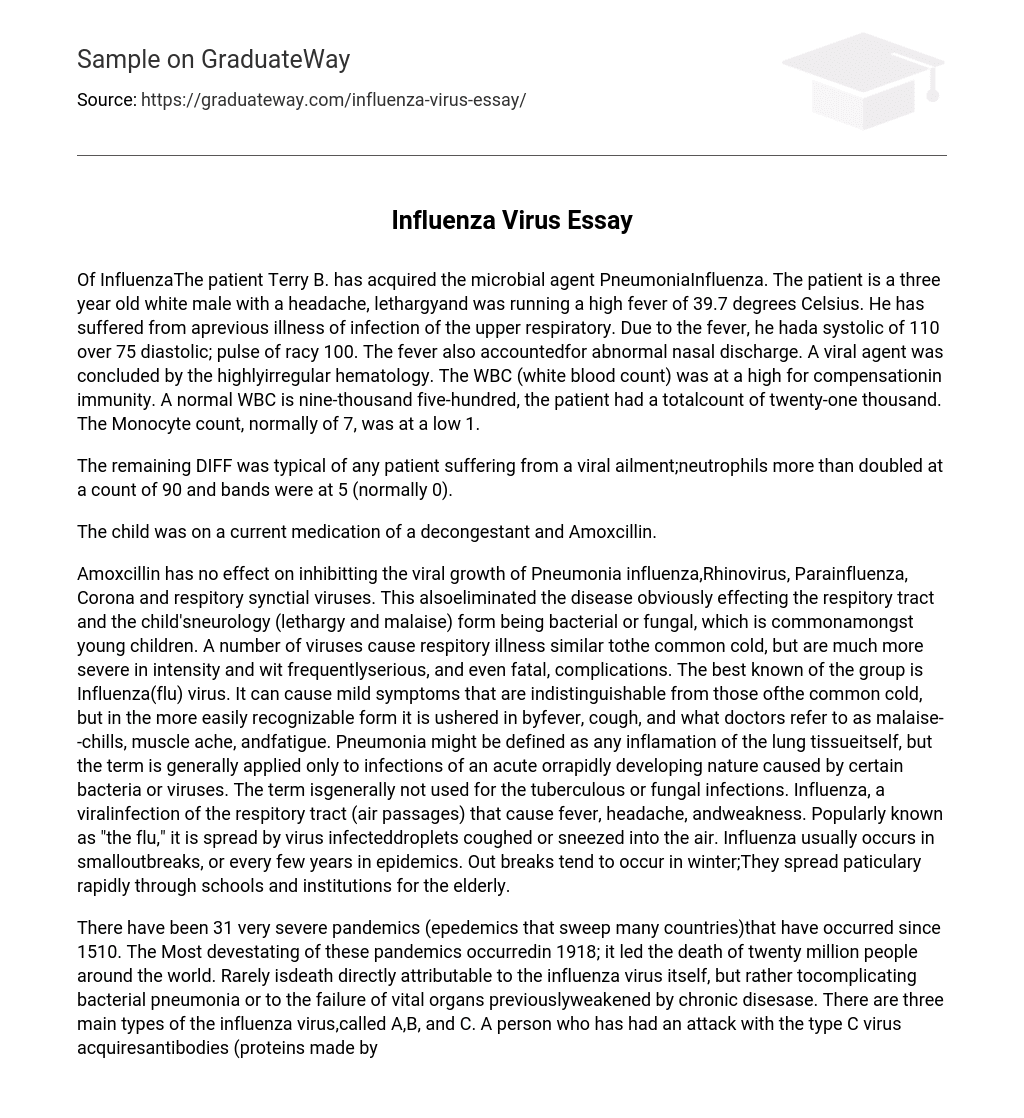Of InfluenzaThe patient Terry B. has acquired the microbial agent PneumoniaInfluenza. The patient is a three year old white male with a headache, lethargyand was running a high fever of 39.7 degrees Celsius. He has suffered from aprevious illness of infection of the upper respiratory. Due to the fever, he hada systolic of 110 over 75 diastolic; pulse of racy 100. The fever also accountedfor abnormal nasal discharge. A viral agent was concluded by the highlyirregular hematology. The WBC (white blood count) was at a high for compensationin immunity. A normal WBC is nine-thousand five-hundred, the patient had a totalcount of twenty-one thousand. The Monocyte count, normally of 7, was at a low 1.
The remaining DIFF was typical of any patient suffering from a viral ailment;neutrophils more than doubled at a count of 90 and bands were at 5 (normally 0).
The child was on a current medication of a decongestant and Amoxcillin.
Amoxcillin has no effect on inhibitting the viral growth of Pneumonia influenza,Rhinovirus, Parainfluenza, Corona and respitory synctial viruses. This alsoeliminated the disease obviously effecting the respitory tract and the child’sneurology (lethargy and malaise) form being bacterial or fungal, which is commonamongst young children. A number of viruses cause respitory illness similar tothe common cold, but are much more severe in intensity and wit frequentlyserious, and even fatal, complications. The best known of the group is Influenza(flu) virus. It can cause mild symptoms that are indistinguishable from those ofthe common cold, but in the more easily recognizable form it is ushered in byfever, cough, and what doctors refer to as malaise–chills, muscle ache, andfatigue. Pneumonia might be defined as any inflamation of the lung tissueitself, but the term is generally applied only to infections of an acute orrapidly developing nature caused by certain bacteria or viruses. The term isgenerally not used for the tuberculous or fungal infections. Influenza, a viralinfection of the respitory tract (air passages) that cause fever, headache, andweakness. Popularly known as “the flu,” it is spread by virus infecteddroplets coughed or sneezed into the air. Influenza usually occurs in smalloutbreaks, or every few years in epidemics. Out breaks tend to occur in winter;They spread paticulary rapidly through schools and institutions for the elderly.
There have been 31 very severe pandemics (epedemics that sweep many countries)that have occurred since 1510. The Most devestating of these pandemics occurredin 1918; it led the death of twenty million people around the world. Rarely isdeath directly attributable to the influenza virus itself, but rather tocomplicating bacterial pneumonia or to the failure of vital organs previouslyweakened by chronic disesase. There are three main types of the influenza virus,called A,B, and C. A person who has had an attack with the type C virus acquiresantibodies (proteins made by the immune system) that provides immunity againstthe type C virus for life Anyone who has been infected with a certain strand ofthe type A or B viruse acquires immunity to that strain. Both A- and B-typeviruses occasionally alter to prouduce new strains that may be able to dodge orovercome immunity built up from a previous attack, Thus leading to an newinfection. The type B virus is fairly stable, but it occasionly alterssufficiently to overcome resistance. The newe strain often cause small outbreaksof infection. The type A virus is highly unstable; new strains arise constantlythruoghout the world. These are the strains that caused the influenza pandemicsof this century, most notably the Spanish flu in in 1918, Asian flu in 1957, andHon Kong flu in 1968. Pneumonia develops from inhaling infected mucus into thelower respitory passages. The pneumonia coccus is often present in the nasal orthroat secretions of healty people, and it tends to be present even more oftenin the same secretions of an individual with the cold. Under certain conditionsthese secretions may be aspirated, or inhaled, into the lung. There the bacteriarapidly mulitiply and spreads to infect a sizeable area. As with the commoncold, chilling and fatigue often play a role in making this sequence possible.
Any chronic debilitating illness also makes one very susceptible to pneumonia.
The classic symptoms of flu (chills, fever, headache, muscle ache, loss ofappetite, and fatigue) are brought on by types A and B virus. Type C causes onlya mild illness that is indistinguishable to the common cold. In general, type Ais more debilitating than type B. Pnemonia develops very suddenly with the onsetof high fever, shaking chills, chest pain, and a very definite feeling ofsickness or malaise. Within hours enough puss is produced within the lung forthe patient to start coughing up thick yellow or greenish sputum which often maybe tinged or streaked with blood. In all but the mildest cases, a person withinfluenza should rest in bed in a warm, well ventillated room. Analgesics(painkillers) should be taken to relieve aches and pains and to reduce fever. Warmfluids soothe a sore throat and inhaling steam has a soothing effect on thelungs. The response of pneumococal pneumonia to penicillin is at times one ofthe most dramatic thereapeutics in medicine. Smoking and cigarette smoke at allcost should be avoided. The Incidence of pneumonia and bronchitis in infantsexamined over the first trhee years of life showed a definite relationshipbetween these diseases and parents’ smoking habits.





